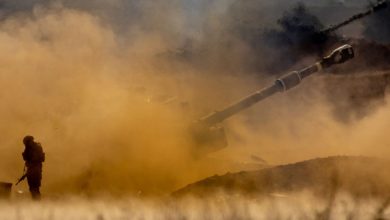Did We Save Wolves Only So We Could Slaughter Them Again?

LIVINGSTON, Mont. — A slaughter of wolves is underway in Montana, Idaho and Wyoming that has no precedent in the past 100 years.
Hunters in Idaho can shoot or trap as many as they like year-round on private land. They can lure wolves within gun range by putting out bait, run them down to exhaustion using A.T.V.s and snowmobiles and stalk them after dark using night vision technology.
Baiting and night hunting are also allowed on private land in Montana, where an individual can kill up to 20 wolves a year by hunting and trapping them. Both states allow bounty payments on dead wolves, which incentivize the bloodshed. In Wyoming, there is no limit on the number that can be killed across 85 percent of the state.
This is all legal. Lawmakers in those states have resumed their longstanding war on gray wolves now that the federal government no longer protects them as threatened with extinction in the region. In all three states, even wolf pups can be killed.
In the face of this all-out assault, the U.S. Fish and Wildlife Service announced in September that it would begin a 12-month review to determine whether “potential increases in human-caused mortality may pose a threat” to the wolves, perhaps exacerbated by new, more permissive regulations in Idaho and Montana. Those two states are home to about 75 percent of the gray wolf population in the Northern Rockies.
We shouldn’t wait for this review to be completed to return these animals to federal protection.
Wolves in the Northern Rockies were exterminated in the early 20th century by federally sponsored predator control programs that were created in the mistaken belief that wolves would drastically reduce wild game and destroy the nascent ranching industry. Then, some 25 years ago, nearly 70 were reintroduced to Yellowstone National Park and the wilderness of north-central Idaho in an effort to restore their populations.
They have thrived. Last winter, there were more than 100 wolves in Yellowstone National Park, with hundreds more in the surrounding region and well over a thousand in Idaho. But this success has been their undoing. In 2011, federal protections were lifted in Montana and Idaho and in 2017 in Wyoming, leaving the fate of the wolves to those states.
Today, not even Yellowstone National Park’s wolves are safe, despite their value to the ecosystem and to visitors who generate hundreds of millions of dollars a year in surrounding communities. In September, three wolves from the Junction Butte pack, a favorite of visitors, were killed by hunters when the animals ventured across the northern border of the park into Montana. Yellowstone’s superintendent, Cam Sholly, said at the time that he would continue “to work with the State of Montana to make the case for reinstating quotas that would protect the core wolf population” in the park.
But at least 15 wolves have been killed by hunters in recent months after crossing outside Yellowstone into Montana, where quotas in the hunting districts bordering Yellowstone were removed last year. At least five others died in Idaho and Wyoming. Park officials recently told The Associated Press that one of Yellowstone’s wolf packs, the Phantom Lake pack, was considered “eliminated” as a result.
Neither Montana nor the other states have paid much heed to Mr. Sholly’s concerns. Idaho’s new law could lead to the reduction of its wolf population by up to 90 percent. In Montana the governor, Greg Gianforte, is among the elected officials who have led the charge. Last February he trapped and killed a wolf near Yellowstone, though he had not taken a legally required trapper education course. He has signed laws making it much easier to kill wolves in his state.
The methods allowed in these states are utterly at odds with the principles of ethical hunting as laid out by the Boone and Crockett Club, a hunting and conservation group. That approach is to pursue game animals in a way that “does not give the hunter an improper or unfair advantage.”
Ranchers whose livelihoods the state legislators cite as endangered by wolves are now complaining that elk are eating too much of their grass and raiding their haystacks — too many elk, in the middle of wolf country! The hunting seasons for elk actually are being extended.
Wolf depredation on livestock has been minimal. In 2015, Idaho, Montana and Wyoming had 1,602,100 cattle in counties where both cattle and wolves were present; there were 1,904 wolves. They killed 148 cattle: about 0.01 percent, or approximately one out of every 10,000 cows. All three states compensate livestock owners for proven losses to wolves.
The ecological consequences of the wolf’s return have been complex. The subsequent reduction and redistribution of elk herds have allowed overbrowsed aspen groves to recover. Is that why the beaver population has increased? Maybe. Nesting songbirds? Probably. The changes ramify throughout the food chain. There can be no doubt that the restoration of one of Yellowstone’s apex predators has been a net benefit. It is now one of the most intact large wild ecosystems in the temperate zones of the planet.
When the gray wolf in the Northern Rockies was removed from the list of species classified as threatened or endangered under the Endangered Species Act, authority over their well-being was placed with the states, on their promises that their management would be sound. Those promises ring rather hollow now.
The only way to stop this killing is to restore federal protection to the gray wolf of the Northern Rockies through the Endangered Species Act, which can be done overnight on an emergency basis.
Conservation groups, dozens of concerned wildlife biologists and managers in Montana, a number of former members of Montana’s Fish and Wildlife Commission and dozens of Native American tribes nationwide have demanded change.
A group of 21 U.S. senators led by Cory Booker, Democrat of New Jersey, and Gary Peters, Democrat of Michigan, recently wrote to Interior Secretary Deb Haaland urging an emergency relisting of the wolf on the federal threatened and endangered species list. Mr. Booker said that the policies “in states like Idaho and Montana, if continued unabated, will result in the deaths of hundreds of gray wolves and pose a significant risk to the species’ survival.” Nearly 80 members of the House have also called for emergency action.
Dan Ashe, a director of the U.S. Fish and Wildlife Service in the Obama administration, told me that “if Secretary Haaland wishes to stop this killing, the Endangered Species Act gives her ample authority and discretion to stop it — cold.”
That’s what she should do.
Thomas McNamee is the author of nearly a dozen books, including two about wolves in the greater Yellowstone region of the West.
The Times is committed to publishing a diversity of letters to the editor. We’d like to hear what you think about this or any of our articles. Here are some tips. And here’s our email: [email protected].
Follow The New York Times Opinion section on Facebook, Twitter (@NYTopinion) and Instagram.





